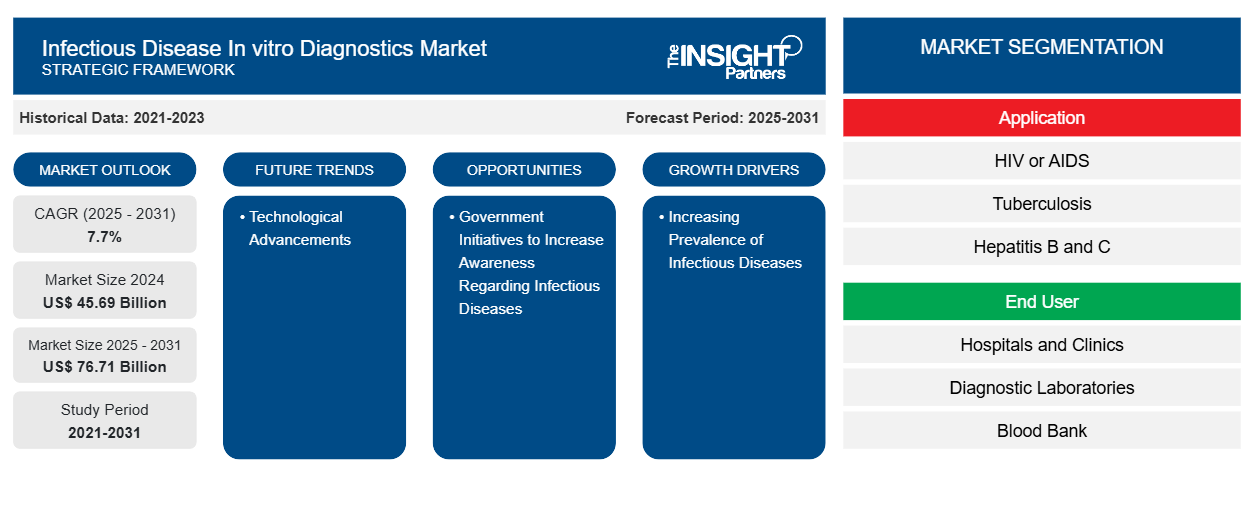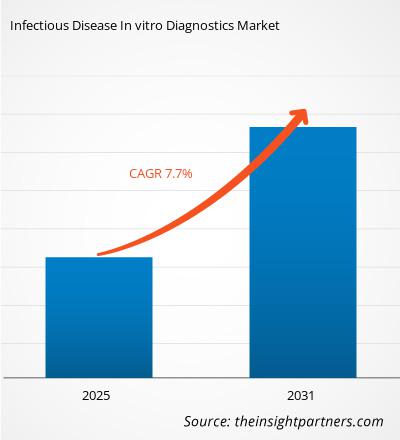传染病体外诊断市场规模预计将从2024年的456.9亿美元增至2031年的767.1亿美元。预计2025年至2031年期间,该市场的复合年增长率将达到7.7%。技术进步可能会为传染病体外诊断市场带来新的趋势。
传染病体外诊断市场分析
由于全球传染病负担日益加重(包括艾滋病毒、结核病、新冠肺炎以及新出现的人畜共患疾病威胁),对早期精准检测的需求日益增加,传染病体外诊断市场正在经历大幅增长。技术创新也发挥着关键作用:PCR、新一代测序、微流体技术和人工智能增强平台等分子诊断技术的进步,使得检测速度更快、更精准、更具多样性。另一个主要增长动力是即时检测和家庭检测的扩展,这得益于远程医疗和消费者对快速居家诊断的偏好。人口结构趋势,尤其是全球人口老龄化加剧,更容易受到感染,进一步支撑了市场扩张。
传染病体外诊断市场概况
全球人口老龄化加剧了这一需求,免疫衰老导致感染风险增加,从而刺激了对可靠诊断工具的需求,全球传染病体外诊断市场正在加速发展。传染病负担日益加重,包括艾滋病毒、结核病、疟疾等长期威胁,以及新冠肺炎、埃博拉和寨卡等新发疾病,对快速、准确的诊断方法的需求持续增长。快速的技术创新是关键的催化剂。下一代分子诊断技术——PCR、NAAT 和 NGS——以及先进的免疫测定、芯片实验室系统和即时诊断设备正在提高灵敏度、特异性和速度。人工智能、机器学习和自动化的集成进一步提高了诊断的准确性和效率,简化了工作流程并实现了预测性监测。这些因素共同推动着全球市场向前发展。
您可以免费定制任何报告,包括本报告的部分内容、国家级分析、Excel 数据包,以及为初创企业和大学提供优惠和折扣
传染病体外诊断市场:战略洞察

- 获取此报告的顶级关键市场趋势。此免费样品将包括数据分析,从市场趋势到估计和预测。
传染病体外诊断市场驱动因素和机遇
传染病流行率上升促进市场发展
根据世界卫生组织 (WHO) 的数据,结核病 (TB) 每年影响全球 1000 万人。尽管结核病可以预防和治愈,但每年仍有 150 万人丧生,是全球主要的传染病死因之一。尽管结核病遍布全球,但大多数病例发生在中低收入国家。近一半的结核病病例发生在以下八个国家:孟加拉国、中国、印度、印度尼西亚、尼日利亚、巴基斯坦、菲律宾和南非。
与全球健康趋势一致,艾滋病毒的流行率在全球范围内持续上升。根据世界卫生组织的数据,截至2023年底,估计有3990万人感染艾滋病毒,预计感染人数将在3610万至4460万之间。全球15至49岁成年人口中约有0.6%受到影响,尽管该流行病的规模和影响在不同国家和地区存在很大差异。
此外,真菌感染的增多是全球广大民众面临的主要问题之一,影响着数百万人。根据全球真菌感染行动基金 (GAFFI) 2024 年的统计数据,每年有超过 8000 万人面临真菌病的高风险,约有 655 万患者会患上危及生命的真菌感染,其中每年有 375 万人死亡。因此,传染病病例的不断增加使得体外诊断成为一项迫切的需求,以便在进行预期治疗之前发现疾病和感染。此外,艾滋病毒、肝炎、结核病、流感和新型病毒感染的流行率不断上升,加剧了对快速精准诊断解决方案的需求。分子诊断技术的创新、更先进的即时检测以及对早期检测和疾病监测的更多重视,共同推动着发达和新兴医疗市场对体外诊断方法的应用。
政府采取措施提高人们对传染病的认识,创造增长机会
政府致力于提高公众对传染病及其诊断的认识,这为传染病体外诊断市场带来了重大机遇。以早期发现、疾病管理和加强卫生系统为重点的举措正在推动全球对诊断产品的需求。
免疫接种运动、学校教育项目和社区筛查等公共卫生举措正在提高公众对诊断检测的认识和利用率。针对结核病、艾滋病毒、肝炎、疟疾和登革热等疾病的国家疾病控制项目已将大规模筛查纳入其中,这导致对集中式和即时诊断平台的需求持续增长。
各国政府也通过研发投入、监管加快和公私合作等方式支持诊断创新。美国国立卫生研究院的 RADx 项目以及欧盟和亚洲的类似项目加强了快速检测和分子检测的开发和部署进程。在中低收入经济体,世界卫生组织的基本诊断清单 (EDL) 以及 FIND 和全球基金等项目正在支持高负担疾病诊断的优先排序和资助。此外,尼日利亚政府通过疾病控制中心 (NCDC) 和卫生部推动针对疟疾、艾滋病毒/艾滋病和结核病的公共卫生运动。这些运动强调早期发现、预防和管理,鼓励更多人寻求诊断检测。随着认识的提高,医疗保健提供者和诊断中心越来越多地采用先进的 IVD 技术,以满足对可靠快速检测日益增长的需求。由政府举措支持的全国性艾滋病毒筛查项目增加了对高效体外诊断试剂盒的需求。同样,在“国家卫生使命”的框架下,印度政府于2023年启动了免费诊断服务计划(FDSI),旨在提供便捷且价格合理的诊断服务,减少医疗自付费用。此外,2024年12月,墨西哥卫生部国家呼吸疾病研究所(INER)“伊斯梅尔·科西奥·维勒加斯”推出了首款基于T2磁共振(T2MR)技术的传染病诊断设备。该技术将有助于对抗抗生素耐药性(AMR)并加快诊断速度。
此外,尤其是在新冠疫情之后,国家对防范战略和疾病监测的投入不断增加,使得传染病诊断成为重中之重。这些举措不仅增强了检测基础设施,还创造了有利的监管和资金条件,使得政府主导的宣传活动成为体外诊断市场增长的主要机遇。
与国际卫生组织的合作以及政府补贴有助于提高这些诊断工具的可及性,尤其是在农村和服务欠缺的地区。这种支持性环境吸引了众多诊断公司的投资,这些公司旨在开发和分销针对特定国家或地区需求的创新检测解决方案。总体而言,政府主导的宣传活动有望通过创造对诊断创新的持续需求,在传染病体外诊断市场创造丰厚的利润。
传染病体外诊断市场报告细分分析
传染病体外诊断市场分析的基础关键部分是应用和最终用户。
- 根据应用,传染病体外诊断市场细分为艾滋病毒/艾滋病、结核病、乙肝和丙肝、疟疾和其他疾病。2024年,乙肝和丙肝占据了最大的市场份额。
- 就最终用户而言,传染病体外诊断市场分为医院和诊所、诊断实验室、血库和其他。2024年,医院和诊所占据了市场主导地位。
传染病体外诊断市场份额(按地区)分析
传染病体外诊断市场报告的地理范围分为五个区域:北美、亚太、欧洲、中东和非洲、南美和中美。
2024 年,北美占据了相当大的市场份额。技术先进产品的接受度不断提高、研发活动的增加、体外诊断试剂盒在传染病诊断中的应用日益广泛,以及大型医疗保健企业的存在,是推动北美传染病体外诊断市场增长的关键因素。该地区传染病的患病率正在上升,主要参与者推出了多种用于诊断的产品。此外,患者和医疗保健提供者对早期疾病检测重要性的认识不断提高,这也支持了市场扩张。政府旨在加强疾病监测和防范的举措和资金进一步促进了该行业的发展。领先的诊断公司的存在以及 FDA 等机构的有利监管框架促进了新检测的快速批准和商业化。此外,老龄化人口更容易受到感染,这也增加了定期诊断筛查的需求。
传染病体外诊断市场区域洞察
Insight Partners 的分析师已详尽阐述了预测期内影响传染病体外诊断市场的区域趋势和因素。本节还讨论了北美、欧洲、亚太地区、中东和非洲以及南美和中美洲的传染病体外诊断市场细分和地域分布。

- 获取传染病体外诊断市场的区域特定数据
传染病体外诊断市场报告范围
| 报告属性 | 细节 |
|---|---|
| 2024年的市场规模 | 456.9亿美元 |
| 2031年的市场规模 | 767.1亿美元 |
| 全球复合年增长率(2025-2031) | 7.7% |
| 史料 | 2021-2023 |
| 预测期 | 2025-2031 |
| 涵盖的领域 | 按应用
|
| 覆盖地区和国家 | 北美
|
| 市场领导者和主要公司简介 |
|
传染病体外诊断市场参与者密度:了解其对业务动态的影响
传染病体外诊断市场正在快速增长,这得益于终端用户需求的不断增长,而这些需求的驱动因素包括消费者偏好的演变、技术进步以及对产品优势的认知度的提升。随着需求的增长,企业正在扩展产品线,不断创新以满足消费者需求,并抓住新兴趋势,从而进一步推动市场增长。
市场参与者密度是指特定市场或行业内企业或公司的分布情况。它表明特定市场空间内竞争对手(市场参与者)的数量相对于其规模或总市值而言。
在传染病体外诊断市场运营的主要公司有:
- 雅培实验室
- F.霍夫曼-罗氏有限公司
- 贝克顿迪金森公司
- Sysmex公司
- 生物梅里埃公司
- Bio-Rad实验室公司
免责声明:以上列出的公司没有按照任何特定顺序排列。

- 获取传染病体外诊断市场主要参与者概览
传染病体外诊断市场新闻和最新发展
传染病体外诊断市场评估是通过收集一手资料和二手资料后进行的定性和定量数据进行的,这些数据包括重要的企业出版物、协会数据和数据库。市场的主要发展情况如下:
- 体外诊断领域的全球领导者生物梅里埃宣布推出其 WATCHFIRE 分子检测解决方案。WATCHFIRE 呼吸道 (R) 检测板针对 22 种病原体,将在 BIOFIRE FILMARRAY TORCH 仪器上运行,并集成 FIREWORKS 软件,以提供废水样本中病毒和细菌的实时趋势分析。(来源:生物梅里埃股份公司,新闻稿,2025 年 4 月)
- 罗氏公司获得美国食品药品监督管理局 (FDA) 批准,推出首个用于筛查美国献血者疟疾的分子检测产品。罗氏公司的 cobas 疟疾检测产品已获 FDA 批准,可用于 cobas 6800/8800 系统。该检测产品可识别受感染的血液单位,从而提高血液供应的安全性。该产品可筛查导致人类感染的五种主要疟原虫。它可用于筛查血液、器官和组织捐献者,从而提高血液的安全性和可用性。(来源:F. Hoffmann-La Roche Ltd,新闻稿,2024 年 3 月)
传染病体外诊断市场报告覆盖范围和交付成果
《传染病体外诊断市场规模和预测(2021-2031)》报告对以下领域进行了详细的市场分析:
- 传染病体外诊断市场规模及全球、区域和国家层面所有主要细分市场的预测
- 传染病体外诊断市场趋势和市场动态,例如驱动因素、限制因素和关键机遇
- 详细的 PEST 和 SWOT 分析
- 传染病体外诊断市场分析涵盖主要市场趋势、全球和区域框架、主要参与者、法规和最新市场发展
- 行业格局和竞争分析,包括市场集中度、热图分析、知名参与者以及传染病体外诊断市场的最新发展
- 详细的公司简介
- 历史分析(2 年)、基准年、预测(7 年)及复合年增长率
- PEST和SWOT分析
- 市场规模、价值/数量 - 全球、区域、国家
- 行业和竞争格局
- Excel 数据集
近期报告
客户评价
购买理由
- 明智的决策
- 了解市场动态
- 竞争分析
- 客户洞察
- 市场预测
- 风险规避
- 战略规划
- 投资论证
- 识别新兴市场
- 优化营销策略
- 提升运营效率
- 顺应监管趋势




















 获取免费样品 - 传染病体外诊断市场
获取免费样品 - 传染病体外诊断市场